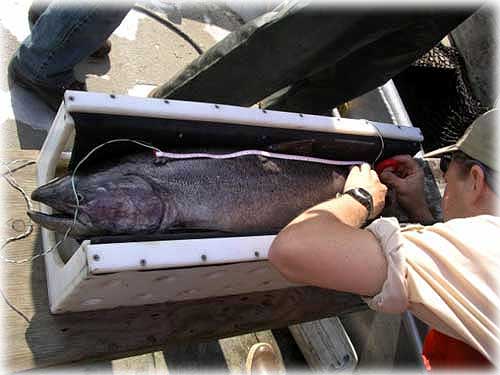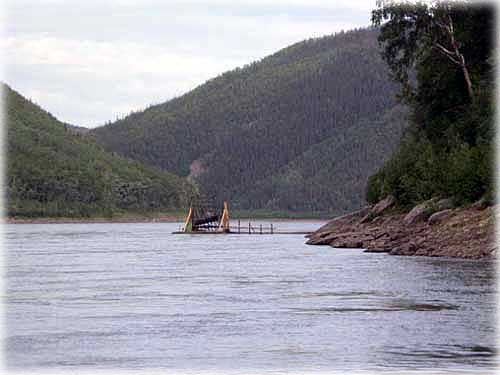 by Ned Rozell April 28, 2006
"Fat is the gasoline in their tank," said biologist Joe Margraf. "Migrating salmon start their trip with that tank, and there's no refueling along the way." Margraf and other scientists have been experimenting with a method to check the primary health indicator of migrating salmon-the fat within their bodies-without killing the fish. Margraf is a fisheries professor with the USGS Alaska Cooperative Fish and Wildlife Research Unit at the University of Alaska Fairbanks.  king salmon on a dead fish from the Yukon River. Photo by Joe Margraf Salmon entering the Yukon River begin their journeys to spawning grounds with huge fat reserves. At the Yukon River's mouth, 20 percent of a fish's body weight might be fat. "(Fat) is what makes salmon such an amazing food," Margraf said. "They have this high percentage of fat, and it's all omega-3s, the good stuff." Fish caught on the lower Yukon are often dripping with fat even after people preserve them by smoking. Fish upriver have lower percentages of fat, and as they make it to their spawning grounds, water replaces most of the fat within their cells. A test of spawning male chum salmon on the Delta River showed that 75 percent of their body weight was water after an 850-mile journey from the mouth of the Yukon. With a reliable indicator of the energy content of Yukon River salmon, biologists could see what shape the fish are in at certain points in the river, and maybe see if any environmental changes are affecting the fish, Margraf said. He and his colleagues are experimenting with a device that they hook up to a fish like tiny jumper cables. A small box then sends a harmless electric current through the fish, and the biologists get a reading of fat and water content within the fish.  Photo by Joe Margraf
Though Margraf's method needs more testing and calibrating for different species of salmon, he said it would help biologists to save fish ("It's pretty hard to put the fish back together after you homogenize them.") Biologists also wouldn't have to handle the fish for more than a minute or so and they wouldn't have to haul fish from a field site. And there's a tie to global warming, too: Learning about the fat in Yukon River salmon might someday allow scientists to see how variables like warmer water temperature or a faster river due to melting glaciers would affect salmon. "At what level might global change eat into a fish's energy level to get upstream?" Margraf said. "The amount of fat they have has been tuned by hundreds of generations of fish. Anything that affects their fuel efficiency has the potential to reduce the survivability of their eggs." Ned Rozell [nrozell@gi.alaska.edu] is a science writer at the institute. Publish A Letter on SitNews Read Letters/Opinions
|